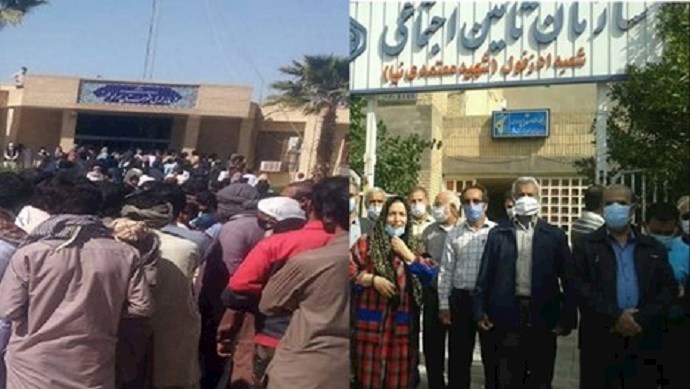Analyzing by PMOI/MEK
Iran, March 02, 2021—On Sunday, 26 cities across Iran saw the sixth round of organized protests by pensioners and other impoverished classes of the society. The protesters, whose living conditions have become utterly miserable due to the corrupt policies of the regime, were chanting slogans like “The streets is the only place where we will get our rights” and “Yesterday’s hard workers are today’s protesters.” Most of these people have spent their lives in public service, as teachers, government employees, and other low-paying jobs in the public sector. The government had promised to support them when they retired. But today, in retirement, they are given very meager pensions that don’t cover their most basic needs.
In the past few years, Iran’s currency has seen a severe decline due to rampant inflation and the government’s destructive policies. For the retirees, however, these changes have not been reflected in their monthly pensions. They still receive the same amount of money they received before the rial lost most of its value. This is against the government’s own policies to adjust pensions based on changes in inflation rates. On Sunday, the pensioners were chanting, “Our main demand is salaries based on inflation” and “We receive our pensions in rial but must pay for our expenses in dollars.”
At the same time, the protesters are fully aware that the constant decline in the country’s economy has not brought any change to the luxurious lives of the ruling elite. “Our pockets are empty, but your conditions are superb,” they were chanting.
According to a 2020 census, there are 18 million pensioners in Iran. These are part of Iran’s impoverished masses, who account for 96 percent of the population and live under the poverty line. Pensioners receive on average 25 million rials per month while the poverty line in some parts of Iran has reached 100 million rials in the past year. Skyrocketing prices are hurting the impoverished segments of the Iranian society in very vital areas. As an example, Hojjatollah Abdulmaleki, the deputy chief of the Khomeini Relief Foundation said on national television on February 28: “In 2018, the average monthly expenditure per capita on food was 1.5 million rials. Today, this figure has reached 6 million rials.”
This means that, with 25 million rials per month, a family of four can barely do anything beyond putting food on their tables. Pensioners, workers, and members of other communities are taking to the streets while, according to a February 28 piece state-run Resalat daily, “Their wages are not even enough to provide them with food, let alone housing, clothing, commute, healthcare, and education.”
According to the regime’s Central Bank, in January, housing rent in Tehran has increased by 32.9 percent in comparison to the previous month. Even the regime’s own officials are admitting that pensions and cash handouts are not solving the people’s problems. On February 27, one MP in the Majlis (parliament) said, “We giving the people 100 units of money but taking out 200 units from their pockets by raising the inflation rate.”
The explosive state of the society
There are a few things that make ongoing protests in Iran significant. First, they are expansive. Six rounds of protests by pensioners clearly paints a picture of widespread discontent across Iran. And in every round of organized protests, more cities join the demonstrations. Regime analysts and media are expressing warnings and concern about the implications of the expanding protests for the regime.
What makes this expansiveness even more significant is the fact that the regime is fully aware of them but is stuck in a situation where it can’t do much to stop them. On the one hand, the regime is poised on quelling any kind of protest, it is also afraid of the backlash that crackdown on protests can have. The memory of the November 2019 protests is still fresh and the regime does not want to trigger another round of nationwide uprisings by making the wrong move against protesters.
As the state-run Jahan-e Sanat newspaper warned on Sunday, poverty and economic divide is “like a time bomb that is ticking under the society’s skin, and since no one knows when this bomb will explode, its threat for the establishment is far more dangerous and destructive than a foreign invasion.”
Second, the protests are becoming increasingly intense and demonstrators are becoming bolder in their rallies and cries against the regime’s injustice and corruption. The intensity of the hatred toward the regime manifested itself in the latest round of protests in Sistan and Baluchestan province, where the brutal crackdown by the regime’s security forces did not succeed in discouraging the protesters. Instead of running away from security forces, the Baluch people, who were outraged by the killing of their compatriots by the Revolutionary Guards (IRGC), stood their ground and forced the regime to back off.
On February 28, the state-run Etemad daily warned, “The recent event in Saravant turned the region into a field for protests and radical incidents, which shows this province is always ready for incidents that are unpredictable and irreparable.”
These are just signs of the explosive potential of Iran’s society, which, after four decades of tyranny, repression, and corruption, is more ready than ever for change. If five rounds of nationwide protests in the past three years are any indication, the next round of protests will happen soon, and they will be even more intense than what we’ve seen to this day.





